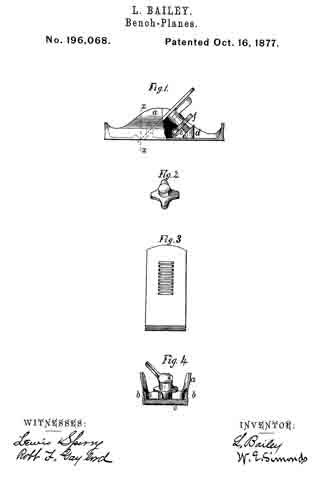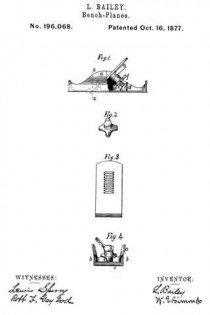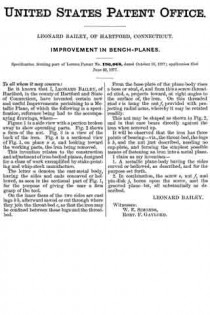
| PLEASE NOTE: The images presented on this page are of low resolution and, as a result, will not print out very well. If you wish to have higher resolution files then you may purchase them for only $2.95 per patent by using the "Buy Now" button below. All purchases are via PayPal. These files have all been cleaned up and digitally enhanced and are therefore suitable for printing, publication or framing. Each zip package contains all the images below (some packages may contain more), and purchased files can be downloaded immediately. |
UNITED STATES PATENT OFFICE.
_________________
LEONARD BAILEY, OF HARTFORD, CONNECTICUT.
IMPROVEMENT IN BENCH-PLANES.
_________________
Specification forming part of Letters Patent No. 196,068, dated October 16, 1877; application filed June 29, 1877.
_________________
To all whom it may concern:
Be it known that I, LEONARD BAILEY, of Hartford, in the county of Hartford and State of Connecticut, have invented certain new and useful Improvements pertaining to a Metallic Plane, of which the following is a specification, reference being had to the accompanying drawings, where —
Figure 1 is a side view with a portion broken away to show operating parts. Fig. 2 shows a form of the nut. Fig. 3 is a view of the back of the iron. Fig. 4 is a sectional view of Fig. 1, on plane x x, and looking toward the working parts, the iron being removed.
This invention relates to the construction and adjustment of iron-bodied planes, designed for a class of work exemplified by stake-pointing and whip-stock manufacture.
The letter a denotes the cast-metal body, having the sides and ends concaved or hollowed, as seen in the sectional part of Fig. 1, for the purpose of giving the user a firm grasp of the tool.
On the inner faces of the two sides are cast lugs b b, afterward sawed or cut through where they join the throat-bed c, so that the iron may be confined between these lugs and the throat bed.
From the base-plate of the plane-body rises a boss or stud, d, and from this a screw-threaded stud, e, projects toward, at right angles to the surface of, the iron. On this threaded stud e is hung the nut f, provided with projecting radial arms, whereby it may be rotated readily.
This nut may be shaped as shown in Fig. 2, and in that case bears directly against the iron when screwed up.
It will be observed that the iron has three points of bearing — viz., the throat-bed, the lugs b b, and the nut just described, needing no cap-plate, and forming the simplest possible means of fastening an iron into a metal plane.
I claim as my invention —
1. A metallic plane-body having the sides curved or hollowed, as described, and for the purpose set forth.
2. In combination, the screw e, nut f, and pin-disk j, borne upon the screw, and the grooved plane-bit, all substantially as described.
LEONARD BAILEY.
Witnesses:
W. E. SIMONDS,
ROBT. F. GAYLORD.


